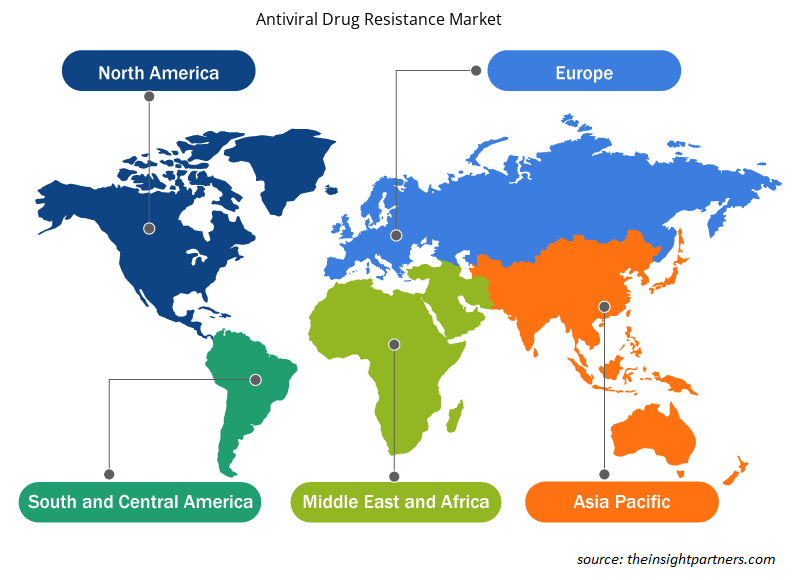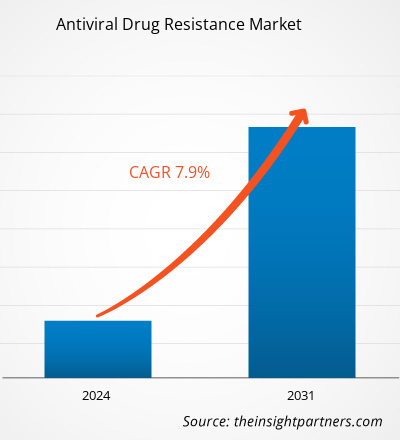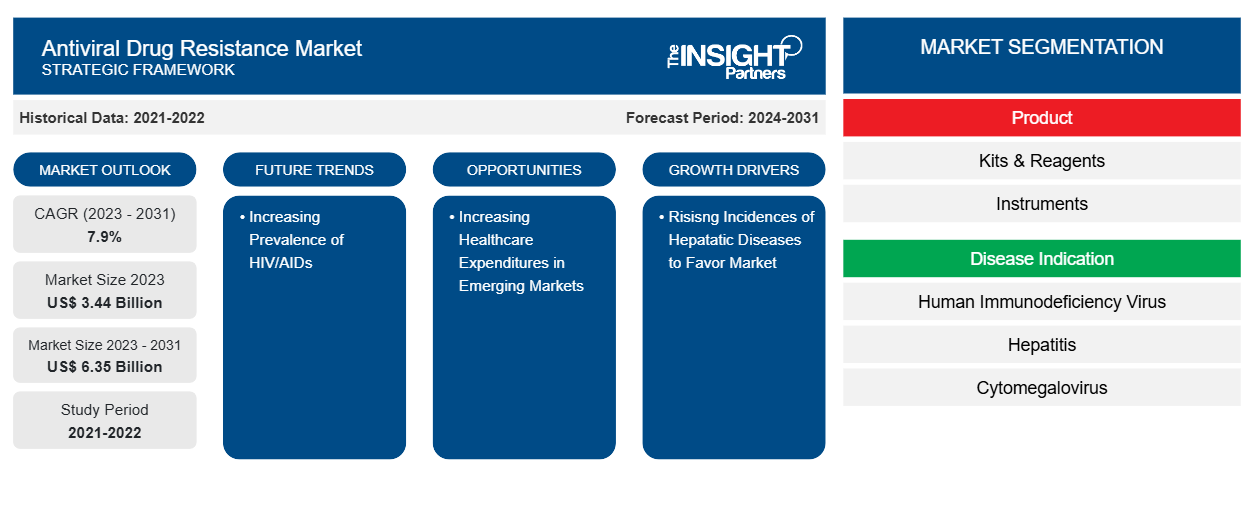抗病毒药物耐药性市场规模预计将从 2023 年的 34.4 亿美元增至 2031 年的 63.5 亿美元。预计 2023-2031 年期间该市场的复合年增长率将达到 7.9%。肝病发病率上升、艾滋病毒和艾滋病的流行以及新兴国家对高质量产品的需求可能仍是市场的主要趋势。
抗病毒药物耐药性市场分析
近年来,全球范围内的 HIV/AIDS 发病率不断上升。获得性免疫缺陷综合征 (AIDS) 是一种慢性、可能危及生命的疾病,由人类免疫缺陷病毒 (HIV) 引起。该病毒会破坏免疫系统,HIV 会干扰人体对抗致病生物的能力。当 HIV 进入人体后,它会在一个月内出现类似流感的疾病。这种疾病被称为原发性或急性 HIV 感染,可能持续数周。根据美国卫生与公众服务部提供的数据以及部长的少数族裔艾滋病倡议基金 (SMAIF) 的支持,2022 年,全球约有 3900 万人感染 HIV/AIDS。绝大多数 HIV 感染者生活在中低收入国家。例如,根据印度 2017 年 HIV 估计报告(国家信息中心),在印度,HIV 的流行率估计为 0.22%(0.16%–0.30%)。此外,男性成人艾滋病毒感染率估计为 0.25%(0.18%-0.34%),女性成人艾滋病毒感染率估计为 0.19%(0.14-0.25%)。因此,预计该国的病毒感染病例将在预测期内推动对抗病毒药物耐药性市场的需求
抗病毒药物耐药性市场概况
多年来,肝炎发病率的上升和艾滋病毒/艾滋病患病率的上升推动了市场的增长。此外,新兴市场的增长可能会在预测期内对市场需求产生积极影响。然而,市场的增长受到替代方法等因素的制约。近年来,美国的艾滋病毒患病率有所上升。根据美国卫生与公众服务部提供的数据以及部长的少数民族艾滋病倡议基金 (SMAIF) 的支持,2021 年有近 32,100 名美国人新感染了艾滋病毒。因此,预计上述因素将在预测期内推动北美抗病毒药物耐药性市场的增长。
定制此报告以满足您的需求
您可以免费定制任何报告,包括本报告的部分内容、国家级分析、Excel 数据包,以及为初创企业和大学提供优惠和折扣
-
获取此报告的关键市场趋势。这个免费样品将包括数据分析,从市场趋势到估计和预测。
抗病毒药物耐药性市场驱动因素和机遇
肝病发病率上升利好市场
病毒是可引起多种传染病(如流感、普通感冒和疣)的微小细菌。病毒还会引起严重疾病,包括天花、艾滋病毒/艾滋病和埃博拉病毒。病毒在细胞内繁殖,能够进入任何活的、健康的细胞,并繁殖和产生其他类似病毒。不同的病毒会攻击体内的特定细胞,如肝脏、大脑、皮肤、血液以及生殖系统、呼吸系统和胃肠系统。近年来,全球范围内肝炎等病毒感染的患病率有所增加。肝炎会导致肝脏损伤和炎症,还会损害其他器官。这是一个全球性的主要健康问题,可导致慢性感染,还会增加死于肝硬化和肝癌的风险。肝炎可分为甲型肝炎、乙型肝炎、丙型肝炎、丁型肝炎和戊型肝炎,它们通过不同的原因传播。据世界卫生组织统计,非洲和西太平洋区域是乙肝发病率最高的区域,这两个区域的成年人口感染率分别达到6.1%和6.2%。
新兴市场医疗支出不断增加
亚太地区、南美洲和中美洲等新兴经济体的医疗支出不断增加,这使得研究人员能够利用 PCR(聚合酶链反应)、下一代测序等先进技术开发多种病毒性疾病的治疗方案。美国国家癌症研究所 (NCI) 等多个组织为 HIV 和艾滋病恶性肿瘤研究提供资金,以研究在慢性 HIV 感染的情况下衰老如何影响癌症的风险、范围和生物学。中国、日本、巴西和其他新兴国家正在大量投入医疗支出,以确立其在市场上的地位,并确保各自国家的医院和研究机构、病理实验室和其他地点使用的仪器和试剂得到适当使用。
抗病毒药物耐药性市场报告细分分析
有助于得出抗病毒药物耐药性市场分析的关键部分是类型、疾病指征、技术和最终用户。
- 根据类型,抗病毒药物耐药性市场分为试剂盒和试剂和仪器。试剂盒和试剂部分在 2023 年占据了最大的市场份额。
- 根据疾病类型,市场分为 HIV、肝炎和巨细胞病毒 (CMV)。HIV 领域在 2023 年占据了最大的市场份额。
- 从技术角度来看,市场细分为免疫诊断、聚合酶链反应 (PCR)、下一代测序 (NGS) 等。2023 年,免疫诊断领域占据了相当大的市场份额。
- 根据最终用户,抗病毒药物耐药性市场分为医院和诊所、病理学或诊断实验室和研究机构。医院和诊所部分在 2023 年占据了最大的市场份额。
抗病毒药物耐药性市场份额(按地区)分析
抗病毒药物耐药性市场报告的地理范围主要分为五个区域:北美、亚太地区、欧洲、中东和非洲以及南美和中美。按地区划分,北美在高流量鼻插管市场中占有最大的市场份额。由于艾滋病毒和肝炎等病毒感染的流行、国家计划的存在以及政府机构的资助等各种因素,预计预测期内市场需求将大幅增长。近年来,美国的艾滋病毒流行率有所上升。根据美国卫生与公众服务部提供并得到部长少数民族艾滋病倡议基金 (SMAIF) 支持的数据,2021 年有近 32,100 名美国人新感染艾滋病毒。预计未来几年亚太地区将以最高的复合年增长率增长。
抗病毒药物耐药性市场区域洞察
Insight Partners 的分析师已详细解释了预测期内影响抗病毒药物耐药性市场的区域趋势和因素。本节还讨论了北美、欧洲、亚太地区、中东和非洲以及南美和中美洲的抗病毒药物耐药性市场细分和地理位置。

- 获取抗病毒药物耐药性市场的区域特定数据
抗病毒药物耐药性市场报告范围
| 报告属性 | 细节 |
|---|---|
| 2023 年的市场规模 | 34.4 亿美元 |
| 2031 年市场规模 | 63.5亿美元 |
| 全球复合年增长率(2023 - 2031) | 7.9% |
| 史料 | 2021-2022 |
| 预测期 | 2024-2031 |
| 涵盖的领域 |
按产品
|
| 覆盖地区和国家 |
北美
|
| 市场领导者和主要公司简介 |
|
抗病毒药物耐药性市场参与者密度:了解其对业务动态的影响
抗病毒药物耐药性市场正在快速增长,这得益于终端用户需求的不断增长,而这些需求又源于消费者偏好的不断变化、技术进步以及对产品优势的认识不断提高等因素。随着需求的增加,企业正在扩大其产品范围,进行创新以满足消费者的需求,并利用新兴趋势,从而进一步推动市场增长。
市场参与者密度是指在特定市场或行业内运营的企业或公司的分布情况。它表明在给定市场空间中,相对于其规模或总市场价值,有多少竞争对手(市场参与者)存在。
在抗病毒药物耐药性市场运营的主要公司有:
- AccuBioTech 有限公司;
- ACON 实验室公司;
- 西门子股份公司;
- 生物梅里埃公司;
- Bio-Rad 实验室公司;
- 丹纳赫;
免责声明:上面列出的公司没有按照任何特定顺序排列。

- 了解抗病毒药物耐药性市场顶级关键参与者概况
抗病毒药物耐药性市场新闻和最新发展
抗病毒药物耐药性市场通过收集来自一级和二级研究的定性和定量数据进行评估,其中包括重要的公司出版物、协会数据和数据库。以下列出了抗病毒药物耐药性市场的一些发展情况:
- – 强生公司旗下的杨森制药公司(Janssen)今天宣布在《自然》杂志上发表新数据,表明一种早期临床候选药物(JNJ-1802)可为非人类灵长类动物和小鼠提供针对登革热的强效保护。这种首创抗病毒药物在 1 期首次人体临床研究中被证明是安全且耐受性良好的,目前正在进入 2 期临床研究,用于预防和治疗登革热。(来源:强生公司,新闻稿,2023 年 3 月)
- Cipla Limited 宣布,该公司已获得印度药品管理总局 (DCGI) 的紧急使用授权 (EUA),可在该国推出 Molnupiravir。Cipla 计划以 Cipmolnu® 品牌推出 Molnupiravir。Molnupiravir 是英国药品和保健产品管理局 (MHRA) 批准的首个口服抗病毒药物,用于治疗有发展为重症风险的轻度至中度 COVID-19 患者。(来源:Cipla,新闻稿,2021 年 5 月)
抗病毒药物耐药性市场报告范围和交付成果
“抗病毒药物耐药性市场规模和预测(2021-2031)”报告对以下领域进行了详细的市场分析:
- 抗病毒药物耐药性市场规模及预测,涵盖范围涵盖的所有主要细分市场的全球、区域和国家层面
- 抗病毒药物耐药性市场趋势,以及驱动因素、限制因素和关键机遇等市场动态
- 详细的 PEST/波特五力分析和 SWOT 分析
- 抗病毒药物耐药性市场分析涵盖主要市场趋势、全球和区域框架、主要参与者、法规和最新市场发展
- 行业格局和竞争分析,涵盖市场集中度、热图分析、知名参与者以及抗病毒药物耐药性市场的最新发展
- 详细的公司简介
- 历史分析(2 年)、基准年、预测(7 年)及复合年增长率
- PEST和SWOT分析
- 市场规模、价值/数量 - 全球、区域、国家
- 行业和竞争格局
- Excel 数据集
近期报告
相关报告
客户评价
购买理由
- 明智的决策
- 了解市场动态
- 竞争分析
- 客户洞察
- 市场预测
- 风险规避
- 战略规划
- 投资论证
- 识别新兴市场
- 优化营销策略
- 提升运营效率
- 顺应监管趋势























 获取免费样品 - 抗病毒药物耐药性市场
获取免费样品 - 抗病毒药物耐药性市场